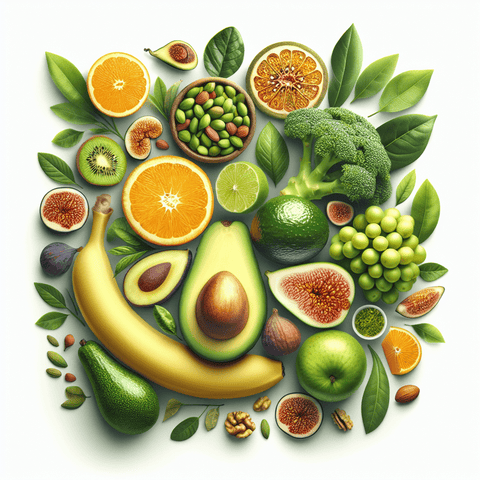Introduction: Understanding the Importance of Magnesium in Nutrition
Magnesium is one of the essential minerals required by the human body for a variety of physiological functions. It’s involved in over 300 enzymatic processes, ranging from muscle and nerve function to supporting energy metabolism and promoting bone health. Adequate magnesium levels are crucial for maintaining electrolyte balance, a healthy cardiovascular system, and optimal muscle performance. Despite its importance, it is estimated that a significant portion of the global population falls short of meeting their daily magnesium intake needs. One way to address this deficiency is to incorporate magnesium-rich foods into the diet — and fruits, being natural, accessible, and nutrient-dense, are an appealing option. While many people associate magnesium primarily with green leafy vegetables, seeds, legumes, or supplements, several types of fruit also offer decent amounts of this important mineral. This blog post explores the role of magnesium, focusing on identifying the richest fruit in magnesium — the avocado — and evaluating how other fruits compare. We’ll take an in-depth look into magnesium content per serving, discuss how fruit cultivation methods influence magnesium density, highlight the best fruit options for supplementation, and provide practical tips for adding these fruits to your diet. Whether you're looking to naturally boost your [magnesium intake](https://www.topvitamine.com/collections/magnesium-benefits-energy-muscle-bone-support) or find a fruit-based alternative to pills, this guide offers you a science-based path toward a more mineral-rich lifestyle.1. Magnesium-Rich Fruit: Avocado – A Top Natural Source for Nutritional Supplements
Among fruits, the avocado stands out not only for its creamy texture, versatility, and healthy fats, but also for its exceptional magnesium content. On average, one medium avocado (approximately 200g in weight) contains around 58 mg of magnesium, which accounts for roughly 15% of the recommended daily intake for adults. Compared to most other commonly consumed fruits, avocados are significantly denser in magnesium, making them an excellent choice for those looking to naturally increase this micronutrient in their diets. The unique nutritional profile of avocado includes a high content of monounsaturated fats, notably oleic acid, along with fiber, potassium, folate, and various B vitamins. This diverse nutrient load makes avocados not only excellent for meeting magnesium intake benchmarks but also ideal for supporting overall metabolic and cardiovascular function. Avocados also complement various eating patterns, including plant-based, Mediterranean, ketogenic, and paleo diets. For individuals choosing to reduce their reliance on synthetic supplements, avocados can serve as a whole-food strategy toward maintaining optimal nutrient levels. In this regard, they're comparable to functional foods that bridge the gap between diet and nutraceuticals. To incorporate more avocado into a magnesium-boosting diet, consider these simple and delicious strategies: - **Smoothies**: Blend avocado with spinach, banana, and almond milk for a rich, magnesium-powered drink. - **Salads**: Dice avocado into grain bowls or mix with citrus fruits for a nutrient-dense salad. - **Avocado Toast**: Serve mashed avocado on whole grain or sourdough toast sprinkled with seeds. - **Guacamole**: Enjoy traditional guacamole with lime juice, garlic, and diced tomatoes. Given the nutrient synergy within avocados, combining them with other [magnesium-rich products from supplements](https://www.topvitamine.com/collections/magnesium-benefits-energy-muscle-bone-support) amplifies the health benefits. People aiming for long-term magnesium optimization can benefit from using avocados both as food and as part of broader dietary goals supported by science-based supplementation.2. Magnesium Content in Fruits: An In-Depth Look at the Numbers
Fruits vary widely in their magnesium content, influenced by species, variety, soil quality, farming techniques, and ripeness at harvest. The bioavailability of magnesium in fruits also depends on how the fruit is consumed — fresh, dried, or processed. For a scientific understanding of this mineral's distribution across fruits, it’s necessary to compare per 100g of edible portion, a standardized metric in nutritional analysis. Here’s a detailed breakdown of magnesium content per 100g for some of the most common fruits: - **Avocado**: 29–30 mg - **Bananas**: 27 mg - **Dried figs**: 68 mg - **Dates**: 43 mg - **Blackberries**: 20 mg - **Papaya**: 21 mg - **Kiwis**: 17 mg - **Guava**: 22 mg - **Raisins**: 32 mg - **Melons (Cantaloupe)**: 10–12 mg - **Strawberries**: 13 mg While fresh fruits tend to offer moderate amounts of magnesium, dried fruits like figs, dates, and raisins stand out due to their higher mineral density per volume. This is largely due to the water removal process, which concentrates the mineral content. Factors influencing the magnesium levels in fruits range from agricultural conditions (soil magnesium levels, irrigation practices, organic vs. conventional farming) to post-harvest handling. For example, organically grown fruits may exhibit higher mineral content due to balanced soil management, though this is not universally true across all studies. The ripeness of a fruit can also affect magnesium levels. Overripe fruits may lose some mineral density over time, whereas fruits harvested at peak maturity retain optimal nutrient levels if consumed shortly after harvesting. Proper storage and minimizing thermal processing help preserve the natural magnesium in fruits. Unlike water-soluble vitamins that degrade quickly with heat, minerals like magnesium are generally more stable, although some loss can still occur with excessive blanching or boiling. For individuals aiming to enhance their diet with [natural supplement-grade nutrition](https://www.topvitamine.com/collections/magnesium-benefits-energy-muscle-bone-support), understanding these subtle factors can significantly improve food choices and nutrient intake strategies.3. Best Sources of Magnesium Fruit: Selecting the Optimal Fruit for Your Diet
Choosing the best fruit source of magnesium for your diet involves several key considerations beyond just numerical content. While the amount of magnesium per serving is important, other factors such as accessibility, taste preferences, cost, gastrointestinal tolerance, and how well the fruit fits into one’s meal planning routine are equally vital. Here are the criteria that define an ideal magnesium-rich fruit: 1. **High magnesium per typical serving size** – Not just high per 100g, but per usual consumption patterns. 2. **Availability and freshness** – Fruits that can be sourced year-round or have long shelf life. 3. **Complementary nutrient profile** – Includes other vitamins or minerals that support magnesium absorption like B6 and potassium. 4. **Pairing potential** – Works well with magnesium-enhancing food combinations. Based on these factors, frontrunners include: - **Avocado** – A whole fruit in a class of its own, with strong magnesium density and high lipid solubility for enhanced nutrient retention. - **Bananas** – Moderate magnesium with excellent potassium levels, ideal for energy and cardiovascular pairing. - **Dates and Dried Figs** – Dense in magnesium and ideal for snack-sized portions or post-workout replenishment. - **Kiwis and Papayas** – Great tropical fruits offering a mix of vitamin C, fiber, and moderate magnesium. Pairing these fruits with [magnesium-based supplementation strategies](https://www.topvitamine.com/collections/magnesium-benefits-energy-muscle-bone-support) can optimize bioavailability. Certain nutrients enhance magnesium uptake — Vitamin B6, for instance, promotes intracellular magnesium transport, and fiber-rich fruits support gut health, potentially improving overall mineral absorption. Equally, recognizing the concept of “nutrient synergy” is crucial. For example, combining bananas with almonds (a rich source of magnesium and healthy fats) enhances both taste and nutrient coverage. A kiwi-avocado smoothie supports both vitamin C and magnesium supplies in an energy-packed, digestible format. Incorporating a wide range of such fruits with supporting supplements is particularly useful for individuals on restricted diets due to allergies, intolerances, lifestyle choices, or medical conditions.4. High Magnesium Fruit Options: Top Choices for Nutritional Supplements
Beyond avocado, several other fruits provide compelling magnesium content, especially when consumed in dried or concentrated forms. These fruits can function as natural, plant-based magnesium sources, fitting well into daily meal prep or being consumed as portable snacks. Here are standout selections: - **Dried Figs**: With up to 68 mg of magnesium per 100g, dried figs are among the highest magnesium-containing fruits. They're also packed with calcium and dietary fiber, offering excellent support for bone health and gut motility. - **Dates**: Approximately 43 mg of magnesium per 100g. Dates also supply potassium and iron, making them ideal for energy support and physical performance recovery. - **Raisins**: Delivering 32–35 mg of magnesium per 100g, raisins also provide vitamin B6 and iron, and act as a high-energy option for athletes or active individuals. - **Bananas**: With around 27 mg of magnesium per 100g and very high potassium levels (~358 mg per 100g), bananas offer easy digestibility and muscle function support. - **Guava**: Offers around 22 mg of magnesium per 100g while being a powerhouse in vitamin C — almost four times the daily recommended intake in one fruit. Suggested daily servings for optimal magnesium through fruit: - **Bananas**: 1–2 large bananas provide up to 50mg of magnesium. - **Avocados**: One whole fruit provides approx. 15% RDI of magnesium. - **Figs/Dates**: 4–5 pieces as a snack can deliver around 50–60 mg. - **Guava/Kiwi**: One medium fruit daily adds approximately 15–20 mg magnesium. By combining these fruits across meals, you can reach up to 150–200 mg of the magnesium RDI from fruit alone. For best results, incorporate them alongside [high-quality supplement options](https://www.topvitamine.com/collections/magnesium-benefits-energy-muscle-bone-support) especially for individuals with increased requirements — such as athletes, pregnant women, or elderly adults.5. Magnesium Levels in Different Fruits: Comparing Popular Choices
To give a clear view of how popular fruits stack up against each other in terms of magnesium content, here is a comparison chart illustrating magnesium amounts per 100g:| Fruit | Magnesium (mg per 100g) |
|---|---|
| Dried Figs | 68 |
| Dates | 43 |
| Raisins | 32 |
| Avocado | 29 |
| Banana | 27 |
| Guava | 22 |
| Papaya | 21 |
| Blackberries | 20 |
| Kiwis | 17 |
| Melons | 10–12 |
6. Natural Magnesium Sources in Produce: Exploring Beyond Fruits
While fruits can provide a solid base of dietary magnesium, combining them with other whole-food sources ensures comprehensive daily coverage. Non-fruit produce options rich in magnesium include: - **Leafy greens**: Spinach (79 mg/100g) - **Nuts & seeds**: Almonds (270 mg/100g), pumpkin seeds (262 mg/100g) - **Legumes**: Black beans (70 mg/100g), kidney beans (35 mg/100g) - **Whole grains**: Brown rice, quinoa, oats These foods paired with fruits generate nutrient synergy. A leafy green salad with sliced avocado and dried figs, or oatmeal topped with banana and raisins, exponentially enhances both flavor and nutritional value. Furthermore, integrating these produce items with [magnesium-focused supplementation](https://www.topvitamine.com/collections/magnesium-benefits-energy-muscle-bone-support) helps cover higher RDI thresholds beneficial for active individuals. Combining fruits with other produce elevates your adherence to a magnesium-rich, low-processed dietary pattern that supports long-term metabolic health in a sustainable way.Conclusion: Incorporating Magnesium-Rich Fruits into Your Health Routine
Magnesium is essential for various crucial bodily processes, including energy production, nerve signaling, and muscle function. Among all fruits, **avocado** emerges as the richest and most versatile option to naturally support magnesium intake. However, other fruits — especially dried figs, dates, bananas, and guavas — offer compelling alternatives, each with unique nutritional advantages. By strategically selecting and combining these fruits across your diet, you can ensure a steady stream of bioavailable magnesium that complements or even reduces the need for supplementation. Pairing these fruits with supportive whole foods or using high-quality, [EFSA-compliant supplements](https://www.topvitamine.com/collections/magnesium-benefits-energy-muscle-bone-support) may further optimize absorption and long-term benefits. With proper planning, your daily magnesium intake can be naturally improved through fruit-based dietary habits, whether for general health, athletic performance, or chronic wellness concerns.Q&A Section
Q: Which fruit contains the highest magnesium content?A: Avocados contain the highest magnesium content among common fruits, with approximately 58 mg per whole fruit. Q: Are dried fruits better sources of magnesium than fresh fruits?
A: Yes, dried fruits such as figs and dates are more magnesium-dense per weight due to water loss during the drying process. Q: Can fruits alone meet daily magnesium needs?
A: Fruits can contribute significantly but may not provide 100% of daily needs. Combining them with vegetables, legumes, and [magnesium supplements](https://www.topvitamine.com/collections/magnesium-benefits-energy-muscle-bone-support) ensures full coverage. Q: Are magnesium levels in fruits affected by cultivation methods?
A: Yes, factors like soil quality, farming practices, and ripeness can influence magnesium content in fruits. Q: How can magnesium-rich fruits be added conveniently to a diet?
A: Smoothies, fruit salads, oatmeal toppings, and healthy snacks with nuts form simple ways to integrate magnesium-rich fruits daily.



